

Memory. Art of Memory (mnemonics) Creating your Memory List of 100. Creating your 100 character Memory List is vital, since you’ll be using this list extensively, and ‘living with’ these characters for years to come.

The 100 List is a cast of characters who will represent each one of the two-digit numbers, i.e. the numbers from 00 to 99. Not only will this give those hundred numbers a ‘face’, but it will make it possible for you to link groups of numbers in such a way that you can ‘see’ them in your mind’s eye. The method is simple: for each pair of digits there is a character involved and a unique action, so the first two digits determine the character, and the next two determine what action that character is performing.
In this way you can build up a scene using memory characters (or cast members, if you like), doing each other’s actions and involving each other in various ways. It might sound complicated at first glance, but it’s straightforward really. Unique actions (or props) Tarzan – swinging on a vine Mike Tyson – punching It doesn’t matter! Top. Acht manieren om je geheugen te verbeteren. Je brein is als een spier.

Human Memory - Online Memory Improvement Course. Research in memory psychology shows that it is possible to improve your memory performance in specific areas by applying memory techniques.
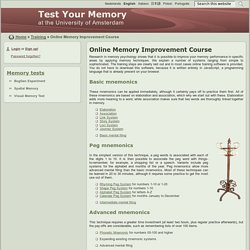
We explain a number of systems ranging from simple to sophisticated. The training steps are clearly laid out and in most cases online training software is provided. You do not have to download this software, because it is written entirely in JavaScript, a programming language that is already present on your browser. Basic mnemonics These mnemonics can be applied immediately, although it certainly pays off to practice them first. Basic mental filing Peg mnemonics. Pseudonumerology. Katapayadi system. KaTaPaYadi System - Values History[edit] The oldest available evidence of the use of Kaṭapayādi (Sanskrit: कटपयादि) system is from Grahacāraṇibandhana by Haridatta in 683 CE.[1] It has been used in Laghu·bhāskarīya·vivaraṇa written by Śaṅkara·nārāyaṇa in 869 CE.[2] Some argue that the system originated from Vararuci.[3] In some astronomical texts popular in Kerala planetary positions were encoded in the Kaṭapayādi system.
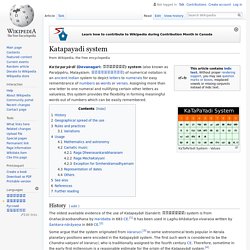
The first such work is considered to be the Chandra-vakyani of Vararuci, who is traditionally assigned to the fourth century CE. Mnemonic major system. The Major System (also called the phonetic number system, phonetic mnemonic system, or Herigone's mnemonic system) is a mnemonic technique used to aid in memorizing numbers.
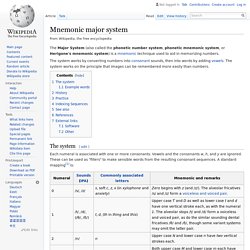
The system works by converting numbers into consonant sounds, then into words by adding vowels. The system works on the principle that images can be remembered more easily than numbers. The system[edit] Each numeral is associated with one or more consonants. Vowels and the consonants w, h, and y are ignored. Mnemonic peg system. A Peg system is a technique for memorizing lists.
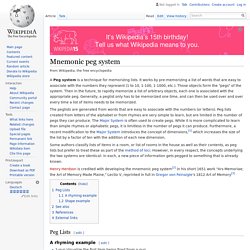
It works by pre-memorizing a list of words that are easy to associate with the numbers they represent (1 to 10, 1-100, 1-1000, etc.). Those objects form the "pegs" of the system. Memory. Neuroscientists reveal how the brain can enhance connections. When the brain forms memories or learns a new task, it encodes the new information by tuning connections between neurons.

MIT neuroscientists have discovered a novel mechanism that contributes to the strengthening of these connections, also called synapses. At each synapse, a presynaptic neuron sends chemical signals to one or more postsynaptic receiving cells. In most previous studies of how these connections evolve, scientists have focused on the role of the postsynaptic neurons. However, the MIT team has found that presynaptic neurons also influence connection strength. "This mechanism that we've uncovered on the presynaptic side adds to a toolkit that we have for understanding how synapses can change," says Troy Littleton, a professor in the departments of Biology and Brain and Cognitive Sciences at MIT, a member of MIT's Picower Institute for Learning and Memory, and the senior author of the study, which appears in the Nov. 18 issue of Neuron.
Judy Willis: What does neuroscience research say about motivation and the brain? January 2014, 1 #4 Driving Question: What does neuroscience research say about motivation and the brain?
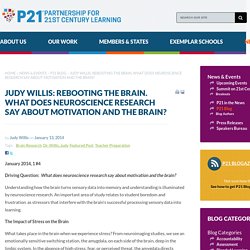
How to Memorize Things Quickly. People like to joke that the only thing you really “learn” in school is how to memorize.

As it turns out, that’s not even the case for most of us. If you go around the room and ask a handful of people how to memorize things quickly, most of them will probably tell you repetition. That is so far from the truth, it’s running for office. If you want to memorize something quickly and thoroughly, repetition won’t cut it; however, recalling something will. The problem is that recalling something requires learning, and we all learn in different ways. How to Rewire Your Brain for Success. The most recent edition of The New Yorker magazine contains an article about neuroscientists who study the way the brain retrieves memories.
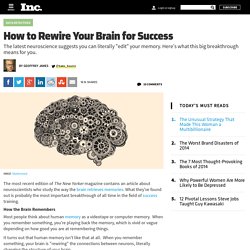
What they've found out is probably the most important breakthrough of all time in the field of success training. How the Brain Remembers. Memory. Memory. Research findings shed light on brain's storage capacity and how memories are kept separate. Researchers have long wondered if there is an upper limit to our capacity to store memories and how we manage to remember so many events without mixing up events that are very similar. To explore this issue, researchers at the Norwegian University of Science and Technology's (NTNU) Kavli Institute for Systems Neuroscience and Centre for Neural Computation and colleagues from the Czech Republic and Italy tested the ability of rats to remember a number of distinct but similar locations.
Their findings are published in the 8 December edition of the Proceedings of the National Academy of Sciences. Repetition Doesn’t Work: Better Ways to Train Your Memory. How the massive influx of tourists impacted prostitution, which is technically legal, in the South American country. In 1920, to prepare for King Albert of Belgium’s visit to Rio de Janeiro, local officials engaged in an extralegal campaign to improve the city’s “moral hygiene.”
Police rounded up all the lower-class prostitutes, cuffed them, and relocated them to the “Mangue”—or downtown marsh district, thereby forming Rio’s very first red light district. Further cleansing occurred in 1967, when police erected walls around the prostitution zone to shield it from the delicate gaze of Queen Elizabeth II in advance of her state visit the following year. The police crackdown on crime also extended to prostitution in order to, as the district attorney stated, “contribute to changing [Rio’s] soiled image.” Thousands of sex websites were reportedly targeted, and Brazil’s leftist president, Dilma Rousseff, took to Twitter to denounce “sexual tourism” during the World Cup. Hack Your Memory: 3 Basic Tricks to Remember Anything. A few years ago my wife and I went on a two-week trek through Italy. Our final stop was Positano, a sleepy coastal town on the Amalfi Coast, and we read voraciously in the sun for days.
It was fantastic. It was during this time that I read Mind Performance Hacks by Ron Hale-Evans (the picture is proof – that’s my 2006 self on a deck in Positano, with my then new glasses and a glass of Italian wine, reading this book. The Method of Loci. This is the first part of your guide to get a memory like an elephant. Memory-Sports.com will give you an insight in the amazing techniques of all mental athletes, starting with the famous Method of Loci. You will learn how to memorize numbers, cards, names and words and discover the fascinating world of Memory Sports.
How to Train Your Brain and Boost Your Memory Like a USA Memory Champion. How to Build a Memory Palace (with Sample) <img alt="Image titled Build a Memory Palace Step 1" src=" width="728" height="546" class="whcdn">1Edit step1Decide on a blueprint for your palace.
While a memory palace can be a purely imagined place, it is easier to base it upon a place that exists in the real world and that you are familiar with or you can use some places of your favorite video game. A basic palace could be your bedroom, for example. Larger memory palaces can be based on your house, a cathedral, a walk to the corner store, or your town. The larger or more detailed the real place, the more information you can store in the corresponding mental space. Using Pattern Recognition to Enhance Memory and Creativity - Maria Popova. "If seven friends in turn rapidly told him their phone numbers, he could calmly wait until the last digit was spoken and then, from memory, key all seven friends' numbers into his phone's contact list without error.
" It seems to be the season for fascinating meditations on consciousness, exploring such questions as what happens while we sleep, how complex cognition evolved, and why the world exists. Joining them and prior explorations of what it means to be human is The Ravenous Brain: How the New Science of Consciousness Explains Our Insatiable Search for Meaning (public library) by Cambridge neuroscientist Daniel Bor in which, among other things, he sheds light on how our species' penchant for pattern-recognition is essential to consciousness and our entire experience of life.
A nap to recap: How reward, daytime sleep boost learning: Findings could benefit educators. A new study suggests that receiving rewards as you learn can help cement new facts and skills in your memory, particularly when combined with a daytime nap. The findings from the University of Geneva, to be published in the journal eLife, reveal that memories associated with a reward are preferentially reinforced by sleep. How Smells Trigger Memories. How to Develop a Photographic Memory.
How to Remember Your Polyatomics. The Science of How Memory Works. By Maria Popova. Memory Improvement. © VeerPRZEMYSLAW PRZYBYLSKI. Train-working-memory. 3 Strategies that Build Long-Term Memory in Corporate Learners. If your corporate learners forget what they learned right after training, were they even trained at all? It’s one of several questions more L&D managers should be asking themselves. These three research-based learning principles should be central to learning design when the goal is retention. How to Train Your Brain to Remember Anything. Memory & brain. How sleep helps us learn and memorize. The easiest way to learn faster and remember longer.
How can I improve my short term memory? 10 Things You Can Do Every Day To Benefit Your Brain. A mind is a valuable thing to waste. You’ve heard the saying many times, but it truly does ring true. BrainTrain - Changing the Way People Think. Insurance coverage varies according to insurance company and state, but all major carriers now cover Cognitive Rehabilitation.
It is billed in 15 minute units with fees paid at $35 to $55 per unit, depending on the region of the country. Thinking and memorizing; test preparation and taking menus. Your Study Guides and Strategies starts here! Memetic engineering. How the brain forms time-linked memories. How Memory Works. Train-working-memory. Super Memory. 8 Ways to Train Your Brain to Learn Faster and Remember More. Train Your Brain to Think Like a Creative Genius. 5 Simple Ways to Increase Your Intelligence. Brain (food) Brain Games & Brain Training.
About the memory, improvement, observation, ... Mnemonic memory.